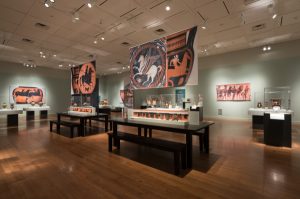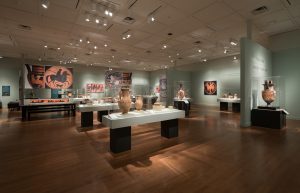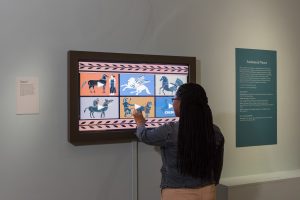
David Stover ©VMFA
In the first exhibition of ancient art in nearly 25 years, VMFA presents The Horse in Ancient Greek Art, an exploration of the Greeks’ fascination with an animal that served as a symbol of wealth, power, and status. Dr. Peter Schertz, Jack and Mary Ann Frable Curator of Ancient Art, shares some insights into the exhibition he co-curated with Nicole Stribling, Curator of Permanent Collections at the National Sporting Library & Museum in Middleburg. On display through July 8, 2018, the exhibition demonstrates how the horse was integral to ancient Greek life and legend, and how many aspects of ancient equestrian culture live on today.

David Stover ©VMFA
What can visitors expect to see in this exhibition?
This exhibition is about Greek art but it is also about the horse in Greek culture and most of the evidence is from the vases on view. When you come in and see the display, it incorporates quotes from ancient sources that help you to think about horses in ancient art and that, I think, will help our visitors understand that this art is the visual manifestation of the Greek culture. Reading ancient writers helps us understand the art and also the phenomenon of the horse. We look at the full range of evidence.
More generally, we wanted to explore how equestrian culture in the past and modern equestrian culture are similar. We have an example of a horse bit in the exhibition from about 2,500 years ago, and it’s just an ancient form of a snaffle bit, exactly like one of the bits they use in modern-day horse riding. Xenophon, who was a student of Socrates, wrote a book called On Horsemanship, and that book is still used as the basis for modern dressage and still contains very important and useful information on how to train a horse and treat a horse. The fact that the book is still relevant is kind of amazing.
What will surprise people the most about this exhibition?
As a curator, I am very pleased with how the exhibition has physically turned out. Ancient art tends to be treated as something very formal, and a lot of people think they need to have specialized knowledge to enjoy it. What I think will surprise people, especially if they look carefully at a number of these vessels, is it’s a really quirky art. . . . You can come into this exhibition and relax and enjoy it and learn. There are activities to do also, but I hope that [visitors] come in and feel like there is nothing off-putting about it. There is no reason they shouldn’t feel as comfortable here as they do anywhere else in the museum, with any other form of art.
What are some of the activities associated with this exhibition?
Many of the objects in the exhibition are vases. Greeks had a number of ways to decorate them, but the most important were red-figure and black-figure painting. Black-figure is essentially the art of silhouette and red-figure allows you do craftsmanship. Our art activity [provides] cut-outs in black and red and encourages people to explore the differences by decorating them.
We worked with a kinetic imaging class from VCU to produce animations. These are 20-, 21-year-old kids who knew nothing about ancient Greek art, but they knew something about animation, and they were inspired by the art to create wonderful animations you can watch.
We worked with a modern poet, Ron Smith [former poet laureate of Virginia], who wrote poems about the exhibition and about works in it because these objects still inspire. We are encouraging people to write their own poems or describe their thoughts in pictures in notebooks in the exhibition. I think that’s a wonderful thing. It’s lovely to see people come in and look at specific objects. People are not just walking through. They are taking their time.
What’s something people should slow down to look for in the exhibition?
There’s this lovely black-figured neck amphora from the Tampa Museum of Art that shows a man grooming a horse. . . . Beneath the handles on this vase are little floral motifs. They are very common motifs and are just supposed to be decorative, but here the artist has shown the horse nibbling at the motif. He’s sort of breaking the logic of the depiction because that floral motif really was meant to be decorative. But the artist said, ‘What’s a horse going to do?’ He’s sees a vine growing nearby, he’s going to eat it. It’s very charming.
What’s fun is discovering the personalities being expressed on these vessels. You really have to spend the time to look at the details. . . . You start to get the sense that actual people made this art. That’s been the biggest delight of the exhibition. There’s a lot of personality and humanity in many of [these vessels]. We start imagining, ‘Who were these people?’ Most of them are craftsman. They don’t have the status of artists the way we think about artists. Often, they are producing hundreds of these vessels so sometimes they’re going to get bored and put in things like the horse nibbling at the decorative foliage.
Is there anything you learned while putting together this exhibition that was a surprise to you?
There was an Olympic competition for about 50 years of mule-cart races. It would never have occurred to me to race mule carts [laughs] but they did, and we know they did because they wrote about it. One of the victors in a mule-cart race commissioned Pindar — one of the great poets of the fifth century BC — to write poems about his victory in a mule-cart race and the guy who won it put a mule cart on his coinage. I still have trouble imagining it. Mule- cart racing — that’s crazier than curling in the winter Olympics these days.
